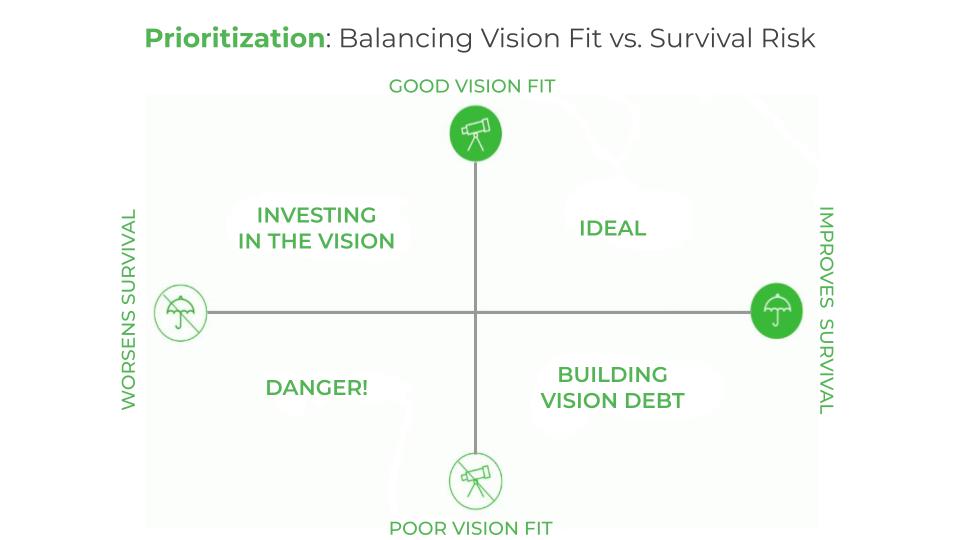Most products only create an incremental change, making the status quo just incrementally better. The rare products that I’ve seen in my career that are truly transformative, have had one common denominator: a product leader that was willing to take a stand.
Behind every visionary product is a product leaders willing to take a stand.
Taking a stand means making clear choices: choosing what you will do, and equally importantly, what you won’t do. Unfortunately, transformative products are so rare because it’s hard to take a stand. Perhaps your sales team is asking you to build features in reaction to what competition is doing. Maybe your feature list might be driven by your CEO entranced by the next shiny object. Or you may be feeling pressure from other teams to settle for a suboptimal solution because what the user truly needs requires tackling hard problems across the organization.
The common and simplistic advice on taking a stand is to “Just stop to ask the five Why’s before you agree to take on a feature”. This tip may be helpful to someone who is new to building products. But if you have experience in building products, you’ll find this advice superficial.
Truly transformative products are rare because it’s hard to push for the choices that you believe are right.
Why it’s hard to take a stand
Here are the top three reasons I’ve observed on why it’s hard to take a stand and why most products don’t end up being transformative:
1. Lack of bandwidth:
When you’re overworked and your tasklist feels hopelessly infinite, it’s hard to push back on features that you think should not be added to your product. Especially when your sales person articulates a feature clearly, the motto of “Just do it” sounds sweeter than a siren’s call. Similarly, when you have too much on your plate, a good enough solution feels like it should suffice for the user - you just don’t have the bandwidth to fight for more.
2. Lack of vision: It’s easy to get mired in everyday tactical activities and derive satisfaction from executing well on the tasks at hand. As a result, there’s little impetus to step back and reflect on your vision and the change you want to create in the world through your product. If you reflect on this vision, it becomes easier to question if your tactics are helping bring about this end state.
3. Lack of psychological safety:
If you work in a setting where you risk being seen as a troublemaker for questioning what’s being asked of you and pushing back, it’s harder to take a stand. For career advancement, it may feel more effective for every member of a product team to please stakeholders and just deliver what’s being asked for.
Tips for taking a stand
Instead of the simplistic advice of asking the five whys, here are three meaningful tips that can help you take a stand:
1. Develop a detailed vision:
When you have a broad and fluffy vision statement such as “Revolutionizing XYZ industry by being customer-centric and creating shareholder value in the process,” anything that’s bringing in revenues and makes customers happy seems fair game. Such a vision doesn’t help you in taking a stand.
A good vision tells you when you are deviating from it - for this, you need a detailed vision. Your vision must explain the problem you’re setting out to solve, who has that problem and why the status quo is unacceptable. You can use the Radical Vision Statement to create such a vision as a group exercise. It helps you focus on the content without getting stuck on the words.
A group exercise in creating such a vision ensures that you’re not embarking on a lonely fight as a product leader - it’s hard to take a stand if you don’t have buy-in from your organization on a shared vision.
A detailed vision helps you know what you stand for.
2. Role model taking a stand:
Every time you take a stand for your vision, you signal to your team through your efforts that you value it - your team needs to see this before they’ll be willing to take a stand with you.
This is not to say that you never deviate from your vision - you may see an iceberg in your way and you may need to deviate from your vision temporarily in exchange for short-term survival. For example, your cash crunch may require you to develop a custom feature that goes against your vision to win a deal and bring in revenues. But you have to decide how often it’s OK to deviate from your vision and communicate that to your team.
You can communicate the tradeoffs you’re making by using the Radical Product Thinking prioritization rubric of Vision vs. Survival. It makes these tradeoffs explicit by categorizing decisions into 4 quadrants:
- Ideal: These are easy decisions that are good for your long-term vision and short-term survival
- Investing in the Vision: Helps progress towards your vision but isn’t helping short-term survival, e.g. taking 3 months to refactor code
- Building Vision Debt: Similar to technical debt, it detracts from your long-term vision but helps you survive in the short term, e.g. taking on a custom feature to win a mega client
- Danger!: Bad for both your vision and survival

Typically, the pressure you’re facing is to drive results in the short-term. As a result, taking a stand often means doing things in the Investing in the Vision quadrant. Keep track of how often you’re investing in the vision, vs. taking on vision debt. Acknowledge vision debt and communicate why it was essential to take it on - this helps you avoid a general loss of faith in the vision so your team will continue to take a stand with you.
Taking a stand requires investing in your vision.
3. Create space for your team:
When your team is overwhelmed with work, they don’t have time to think about your shared vision, how many tradeoffs they’re making and how often they’re giving up on that vision. In this setting, it’s easy to become a rudderless boat - going wherever the currents take you.
To overcome this, evaluate the work culture you’re experiencing and if you have the bandwidth for meaningful work. In design, we know that intent is not impact. Similarly, the culture you intend to have in your organization might not be the culture people are experiencing.
The Radical Product Thinking rubric for culture helps you articulate the team is experiencing. Conduct the culture exercise with your team to understand if your culture supports innovation (and taking a stand). Once you articulate your current work culture, you can craft a RDCL Strategy for how you can bring about that culture change your team needs.
You may want to share your findings with the executive team if you need to create space for meaningful work time. Remember that even if you can’t change the culture across your organization, taking this approach will help you to create a good working culture within your team.
You can engineer a work culture that allows teams to take a stand.
Conclusion
Regardless of the title you hold, it’s hard to take a stand when you don’t have bandwidth, when you’re mired in everyday tactics, and when you don’t have psychological safety. Taking a stand is hard but the rewards are worth it - your ability to build visionary products depends on it. Using these three tips above, you can make it easier for you and your team to take a stand and make clear choices on what you will and won’t do in your product.
